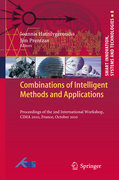
Combinations of intelligent methods and applications: Proceedings of the 2nd International Workshop, CIMA 2010, France, October 2010
Hatzilygeroudis, Ioannis
Prentzas, Jim
The combination of different intelligent methods is a very active research area in Artificial Intelligence (AI). The aim is to create integrated or hybrid methods that benefit from each of their components. Some of the existing efforts combine soft computing methods either among themselves or with more traditional AI methods such as logic and rules. Another stream of efforts integrates machine learning with soft-computing or traditional AI methods. Yet another integrates agent-based approaches with logic and also non-symbolic approaches. Some of the combinations have been quite important and more extensively used, like neuro-symbolic methods, neuro-fuzzy methods and methods combining rule-based and case-based reasoning. However, there are other combinations that are still under investigation, such as those related to the Semantic Web. The 2 Workshop on “Combinations of Intelligent Methods and Applications” (CIMA 2010) wasintended to become a forum for exchanging experience and ideas among researchers and practitioners who are dealing with combining intelligent methods either based on first principles or in the context of specific applications. CIMA 2010 was held in conjunction with the 22 IEEE International Conference on Toolswith Artificial Intelligence (ICTAI 2010). Also, a special track was organized in ICTAI 2010, under the same title. This volume includes revised versions of the papers presented in CIMA 2010 and one of the short papers presented in the corresponding ICTAI 2010 special track. It also includes a paper of the editors as invited. Recent research on the Combination of Intelligent Methods and Applications. Proceedings of the 2nd International Workshop, CIMA 2010, France, October 2010. Written by leading experts in the field. INDICE: Defeasible Planning through Multi-Agent Argumentation. -Operator behavior modelling in a submarine. -Automatic Wrapper Adaptation by Tree Edit Distance Matching. Representing Temporal Knowledge in the Semantic Web: The Extended 4D Fluents Approach. Combining a Multi-Document Update Summarization System –CBSEAS– with a Genetic Algorithm. Extraction of Essential Events with Application to Damage Evaluation on Fuel Cells. Detecting car accidents based on traffic flow measurements using machine learning techniques. Next Generation Environments for Context-aware Learning Design. Neurules-A Type of Neuro-Symbolic Rules: An Overview.
- ISBN: 978-3-642-19617-1
- Editorial: Springer Berlin Heidelberg
- Encuadernacion: Cartoné
- Páginas: 170
- Fecha Publicación: 15/04/2011
- Nº Volúmenes: 1
- Idioma: Inglés
